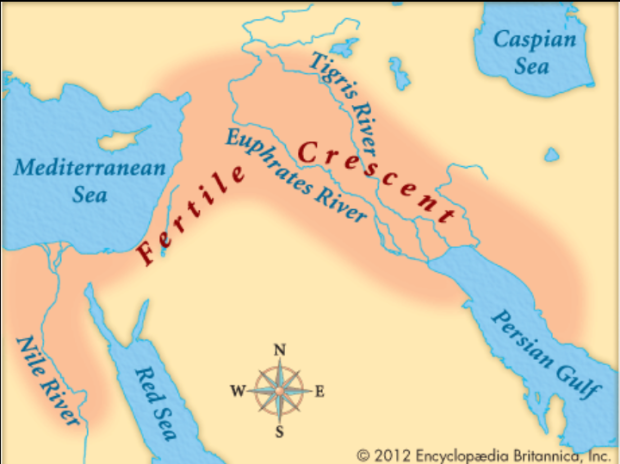The fertile crescent has birthed many religions, some which we still practice today such as Islam, Judaism and Christianity. Being the self appointed research historian I am, I did alot of research and here is a summary, for all my history nerds.
First things first, the fertile crescent is a crescent shaped fertile area that stretches from the Mediterranean Sea to the Persian gulf. The region includes modern day Israel, Jordan, Lebanon, Turkey, Syria and Iraqi.

A Polytheistic fertile crescent.
By 3000 B.C. the Sumerians had formed 12 city states in the Tigris-Euphrates valley which included the famous cities of Babylon, Ur, Uruk and Eridu. Each city state had a chief deity who was worshipped in a Ziggurat / temple ( The Ziggurat was made of sun-dried bricks and decorated with colored tiles. A staircase climbed to a shrine atop the Ziggurat).

The Sumerian deities included; Anu, Enlil, Utu, Nanna, Inanna, Ninhursag, Enki, Nergal, Tamuz… The list goes on. Although the Sumerians worshipped and honored their many gods, they felt no personal connection with them. They pictured their deities as unpredictable and selfish beings who had little regard for human beings. Ordinary people depended on their own personal deities who not only protected them but also acted as mediators between them and the greater deities. The Sumerians also loved adventure tales. A good example is the story of Utanapishtum of Shurrupak ( a summary);
The gods were planning to create a great flood. The god Ea, warned Utanapishtum of the great flood and advised him to tear down his house, build a ship and into the ship bring seed of all living creatures. Utanapishtum did as advised, he took his family into the boat and closed the door. The old gods were ashamed of what they did and Ishtar cried ‘O how could I have done this to my people!’. Utanapishtum sent out birds to confirm whether the flood had subdued. When the flood subdued, the god Enlil touched his forehead and blessed his family.
Adapted from Gilgamesh. Retold by Herbert Mason.
NB: There is a striking similarity between the Bible’s Noah, and Utanapishtum of Shurrupak. Skeptics argue that the Jews borrowed the story from the Gilgamesh account that dates back to the 2000s B.C. I Believe the flood was an actual event that was passed down through generations. Since the Bible is God inspired, it therefore is a more accurate depiction!
The Akkadians ( nomadic semites) invaded and conquered the Sumerians in the 2000s B.C. led by Sargon I. According to legend, Sargon was born a herder, his mother abandoned him as a baby, setting him in the Euphrates river in a reed basket where a farmer found him and raised him as his own. The Akkadians adopted the Sumerian deities and practices.
The Amorites arose under a powerful ruler Hammurabi, whose main capital city was Babylon. They were a polytheistic people with deities such as Marduk, who was later known as Bel meaning ‘lord’, Shamash, Nergal, Tiamat and Ea.
The Assyrian empire rose to it’s full glory by about 650 B.C. with it’s capital city at Nineveh. The Assyrians worshipped deities such as Ashur, Ishtar, Shamash, Eilil and Ea.
The Monotheistic fertile crescent.
The Bible remains one of the main rich source of the fertile crescent history. Abraham originally lived in the city of Ur, where they worshipped the moon god Nanna. Around 1900 B.C. Abraham left Ur, along with his family and belongings and became a nomad. Linking Egypt and Mesopotamia was a strip of land called Canaan which The God of Abraham, Yahweh, had decided to give him. Yahweh determined wrong and right and expected people to act justly with each other. The teachings exist today as the religion of Judaism that shares many of its aspects with Christianity and Islam.
The Persians were the most powerful nation in the fertile crescent during the 540s B.C., under the powerful Cyrus. They were Polytheistic up until the 570 B.C. when a prophet called Zoroaster called for religious reforms. He preached that the world was divided by a struggle between good and evil. The god Ahura Mazda led the forces of good and a villain god, Ahriman, led the forces of evil. At the end of time, Ahura Mazda would triumph over Ahriman. Zoroaster also taught that humans had to choose between good and evil. Those who fought on the side of Ahura Mazda would be rewarded with eternal life and those who chose Ahriman would be condemned after death to eternal darkness and misery. These teachings were recorded in a book called the Avesta.
Christianity began with a Jew named Jesus who grew up in Nazareth. Jesus travelled through Galilee and Judea from about A.D. 30 to A.D. 33, preaching and winning followers. Jesus urged the people to turn away from sin. He urged that God was all forgiving towards all those that repented no matter how evil they’d been. Jesus’ disciples believed he was the Messiah, while other Jews considered Him as a somewhat astray Rabbi. In about A.D. 33, Jesus was arrested as a political rebel and crucified. After Jesus’ death, his disciples proclaimed He’d risen from death and began preaching Jesus is the way to salvation. His teachings are recorded in the Bible’s new testament.
Islam which means ‘ submission to the will of Allah ‘ began with Muhammad. After his marriage to Khadija, a wealthy widow, Muhammad spent time alone praying and fasting in a cave. In A.D 610, Islamic teachings hold that Muhammad had a vision calling him to be the apostle of the one true God Allah, to ‘recite’ and to ‘ rise and warn’ . Muhammad preached on social justice and equality. After a brief illness, Muhammad died at Madinah in the A.D. 632. His teachings have been recorded in the Quran.